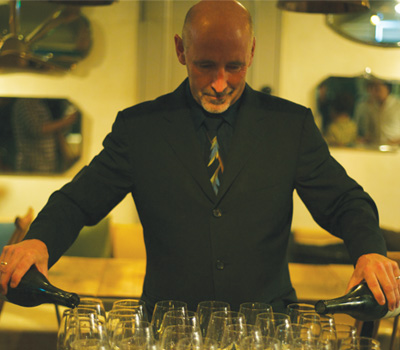Thirty years ago, Jonathan Waters took a job as a busboy at Chez Panisse. He became maître d’ in the early 1990s, a job he still holds, as well as having directed the wine list for more than a decade. Like the menu, his list changes with the seasons and, recently, it is beginning to reflect new Italian directions in the kitchen, adding to the French connection, as well Alice Waters’ emphasis on local sourcing of the food.


On pouring Clos Roche Blanche Touraine blanc in lieu of Sancerre
I could sell cases and cases of that. It’s partly my staff as the engine of my sales, and partly customer desires. The staff likes Loire wines, but they don’t like Sancerre very much. They really like these Touraine blancs, the Montlouis, these wines that combine sweet and sharp, sweet and minerally. I know sweet is a word people eschew; call it that blush of fruit.
Sauvignon blanc is a grape that always makes itself known in a wine. And Sancerre became a model that was mimicked around the world. It’s in that box of grassy, green pea, hay, fresh sauvignon blanc flavors—not the more expensive, deeper flavored wines. It’s a little closer to the glass-pour sauvignon blancs from anywhere. Sancerre was a model for so many other wines from New Zealand to Chile. People tried to mimic Sancerre and sauvignon blanc said, “Yeah, I’ll go there with you.”
If I could find a Sancerre that I thought was distinctive, with simple farming, low intervention, if I could find a Sancerre that would fit these bills, I’m sure it would go well.
Some sommeliers will always choose to list a Sancerre over a Touraine blanc. I have the benefit of a staff that knows the smaller AOCs, and also a customer base that comes in trusting our source of ingredients. They come in with faith in Chez Panisse, so they are more willing to say, “Well, I don’t know any of the these wines, so let’s try some of them.” I tend to like wines from lesser-known AOCs, and they are also less expensive as a general rule. You can find quality in places that are less well known than you might in more traditional spots.
On selling local
I want to pour local wines if I can, price-wise as well as flavor profile-wise.
We sold a lot of the Scribe Sylvaner: there’s someone who came to Chez Panisse for a long time. But it was secondary to me that we knew him and knew what he was doing at his place. But that was the first vintage of his sylvaner that hit it right. It had enough bite to go with the food downstairs. The staff really liked it and we poured it by the glass a lot.
As for the Jodie-Laide Trousseau Gris, Scott [Schultz] makes such a small production. That’s probably more of a hipster wine, pretty small production, gris in color, an orange hue, a stronger wine with stronger flavors. We also poured lots of that juice downstairs. That’s liked for being strong and different; it has a resiny character. They chose it downstairs a lot to go with certain foods. Romesco sauces, or complex flavors. It’s a wine you can take into winter dishes—it has an equivalent viscosity of flavors. It can take the sweet and sour of the sand dab sa-or, a dish with raisins, pine nuts, onions…
Any changes to the list this year?
We’re increasing the Italian presence. Michael Peternell, one of our chefs, is doing more Italian food, so we follow and will put more wines from Italy on. Pigatos, freisa, dolcetto, wines more from smaller areas. I’m looking at the big areas too.
For a long time we didn’t have any official wine pairing downstairs. We’ve only done it for about two years. It’s become more and more popular with guests. I’d say 75 percent of the guests in the downstairs dining room take the wine pairing now. Waiters keep going back to many wines; I want the wine list to expand to give more choices for that idea. We had between 15 to 20 Italian reds, and it behooves me to have more choices.
People really like wine pairings. Ten years ago, people wanted their bottle on the table. Now they want small glasses of different things to taste. They want to know what we chose to go with the food. They want to taste and compare it with the food. They like that exploration to the wines’ flavors with the food.
Joshua Greene is the editor and publisher of Wine & Spirits magazine.
















